Strategic Management Report: CSR, Unilever Case Study, and Analysis
VerifiedAdded on 2022/08/20
|23
|6393
|29
Report
AI Summary
This report comprehensively examines strategic management, focusing on the concept of Corporate Social Responsibility (CSR). It begins by defining strategic management and then delves into CSR, describing its attributes, benefits, and strategic importance for businesses. The report critically analyzes CSR, explaining its role in aligning business strategies with societal objectives, enhancing stakeholder relationships, and driving sustainable growth. The second part of the report presents a real-life case study of Unilever, illustrating the practical application of CSR. This case study highlights Unilever's approach to integrating CSR into its business model, addressing challenges, and achieving positive outcomes. The report concludes by emphasizing the significance of CSR in modern business and its potential to create both societal and organizational value. The report covers topics like strategic planning, business ethics, stakeholder management, and sustainability management, making it a valuable resource for students of management and business.
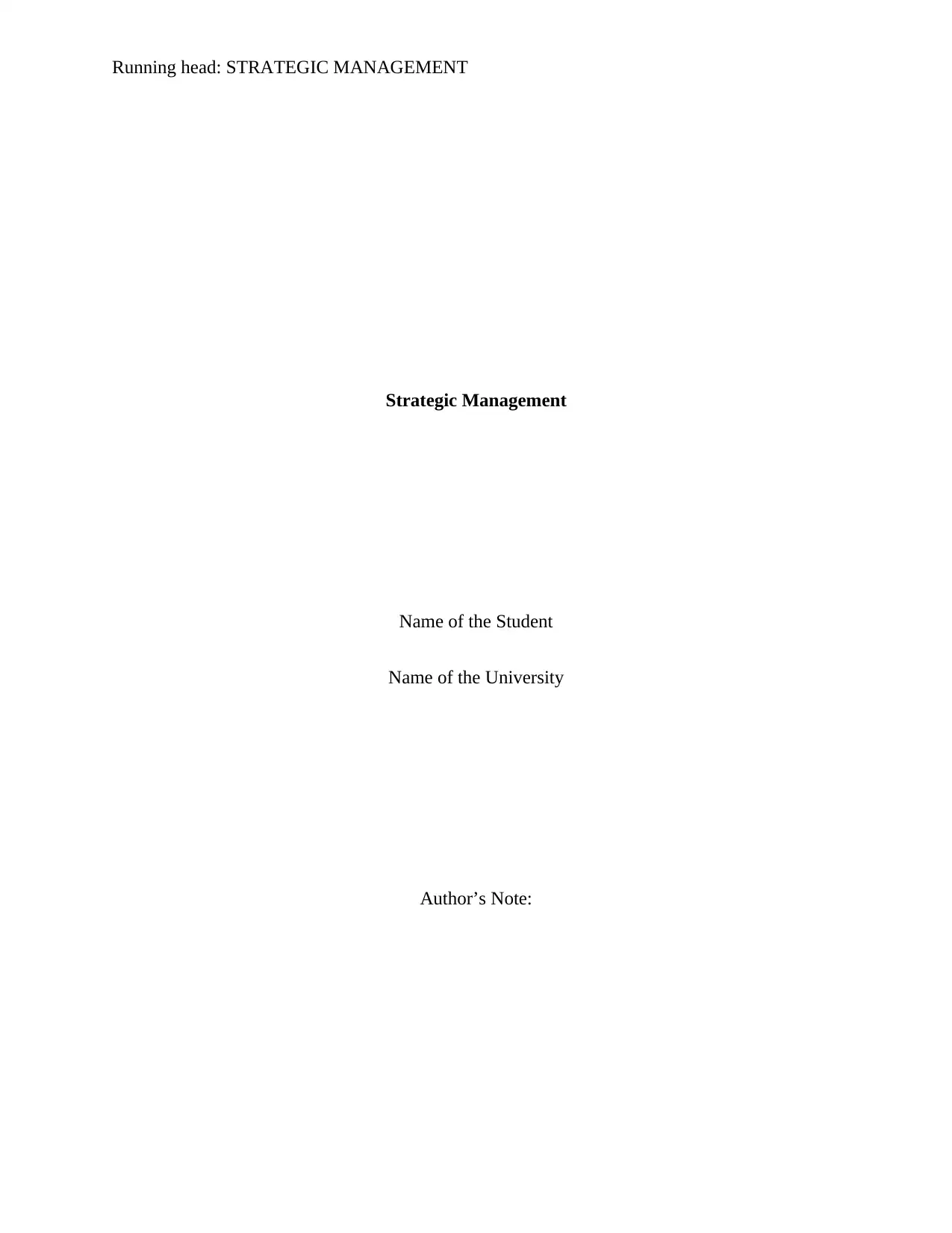
Running head: STRATEGIC MANAGEMENT
Strategic Management
Name of the Student
Name of the University
Author’s Note:
Strategic Management
Name of the Student
Name of the University
Author’s Note:
Paraphrase This Document
Need a fresh take? Get an instant paraphrase of this document with our AI Paraphraser
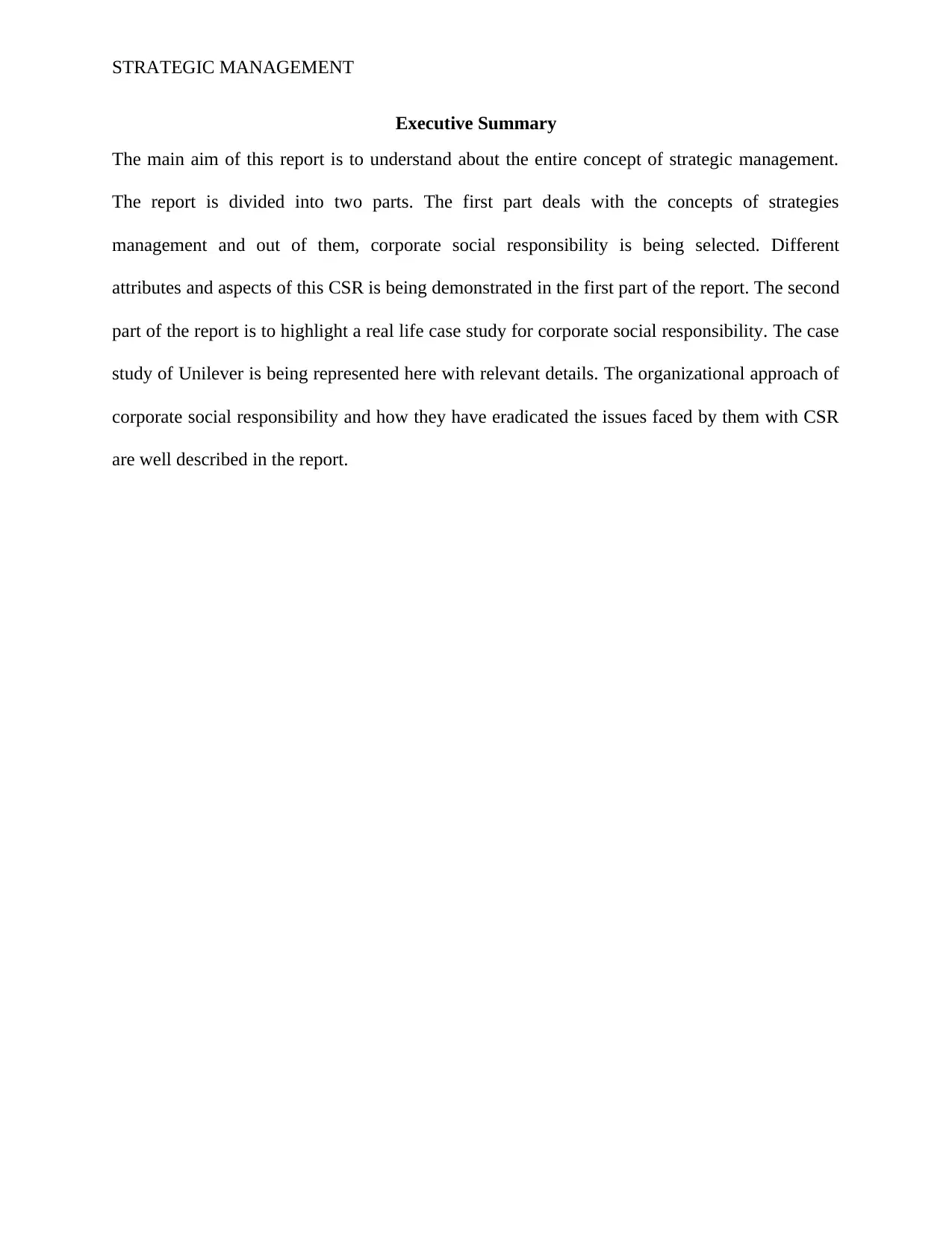
STRATEGIC MANAGEMENT
Executive Summary
The main aim of this report is to understand about the entire concept of strategic management.
The report is divided into two parts. The first part deals with the concepts of strategies
management and out of them, corporate social responsibility is being selected. Different
attributes and aspects of this CSR is being demonstrated in the first part of the report. The second
part of the report is to highlight a real life case study for corporate social responsibility. The case
study of Unilever is being represented here with relevant details. The organizational approach of
corporate social responsibility and how they have eradicated the issues faced by them with CSR
are well described in the report.
Executive Summary
The main aim of this report is to understand about the entire concept of strategic management.
The report is divided into two parts. The first part deals with the concepts of strategies
management and out of them, corporate social responsibility is being selected. Different
attributes and aspects of this CSR is being demonstrated in the first part of the report. The second
part of the report is to highlight a real life case study for corporate social responsibility. The case
study of Unilever is being represented here with relevant details. The organizational approach of
corporate social responsibility and how they have eradicated the issues faced by them with CSR
are well described in the report.
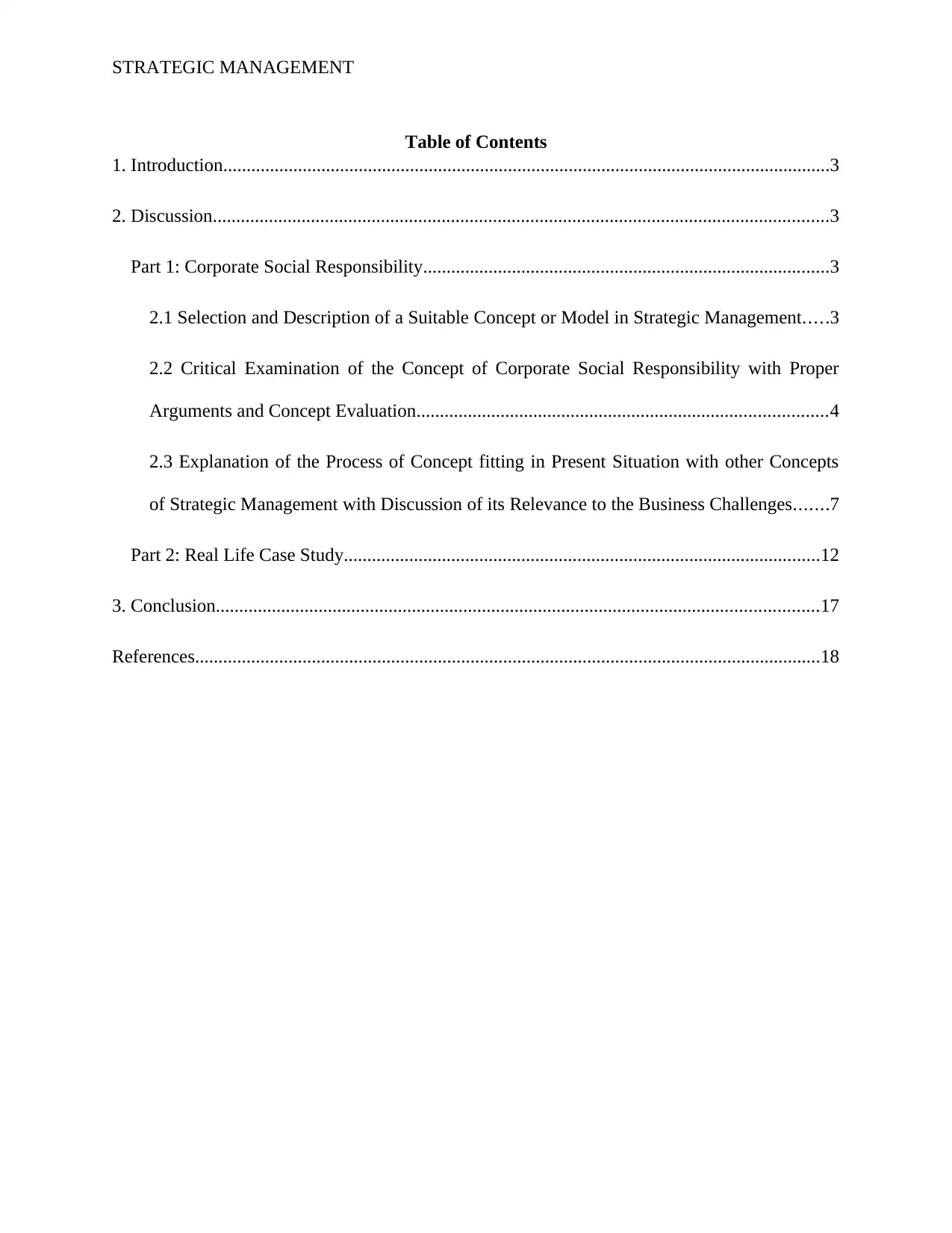
STRATEGIC MANAGEMENT
Table of Contents
1. Introduction..................................................................................................................................3
2. Discussion....................................................................................................................................3
Part 1: Corporate Social Responsibility.......................................................................................3
2.1 Selection and Description of a Suitable Concept or Model in Strategic Management.....3
2.2 Critical Examination of the Concept of Corporate Social Responsibility with Proper
Arguments and Concept Evaluation........................................................................................4
2.3 Explanation of the Process of Concept fitting in Present Situation with other Concepts
of Strategic Management with Discussion of its Relevance to the Business Challenges.......7
Part 2: Real Life Case Study......................................................................................................12
3. Conclusion.................................................................................................................................17
References......................................................................................................................................18
Table of Contents
1. Introduction..................................................................................................................................3
2. Discussion....................................................................................................................................3
Part 1: Corporate Social Responsibility.......................................................................................3
2.1 Selection and Description of a Suitable Concept or Model in Strategic Management.....3
2.2 Critical Examination of the Concept of Corporate Social Responsibility with Proper
Arguments and Concept Evaluation........................................................................................4
2.3 Explanation of the Process of Concept fitting in Present Situation with other Concepts
of Strategic Management with Discussion of its Relevance to the Business Challenges.......7
Part 2: Real Life Case Study......................................................................................................12
3. Conclusion.................................................................................................................................17
References......................................................................................................................................18
⊘ This is a preview!⊘
Do you want full access?
Subscribe today to unlock all pages.

Trusted by 1+ million students worldwide
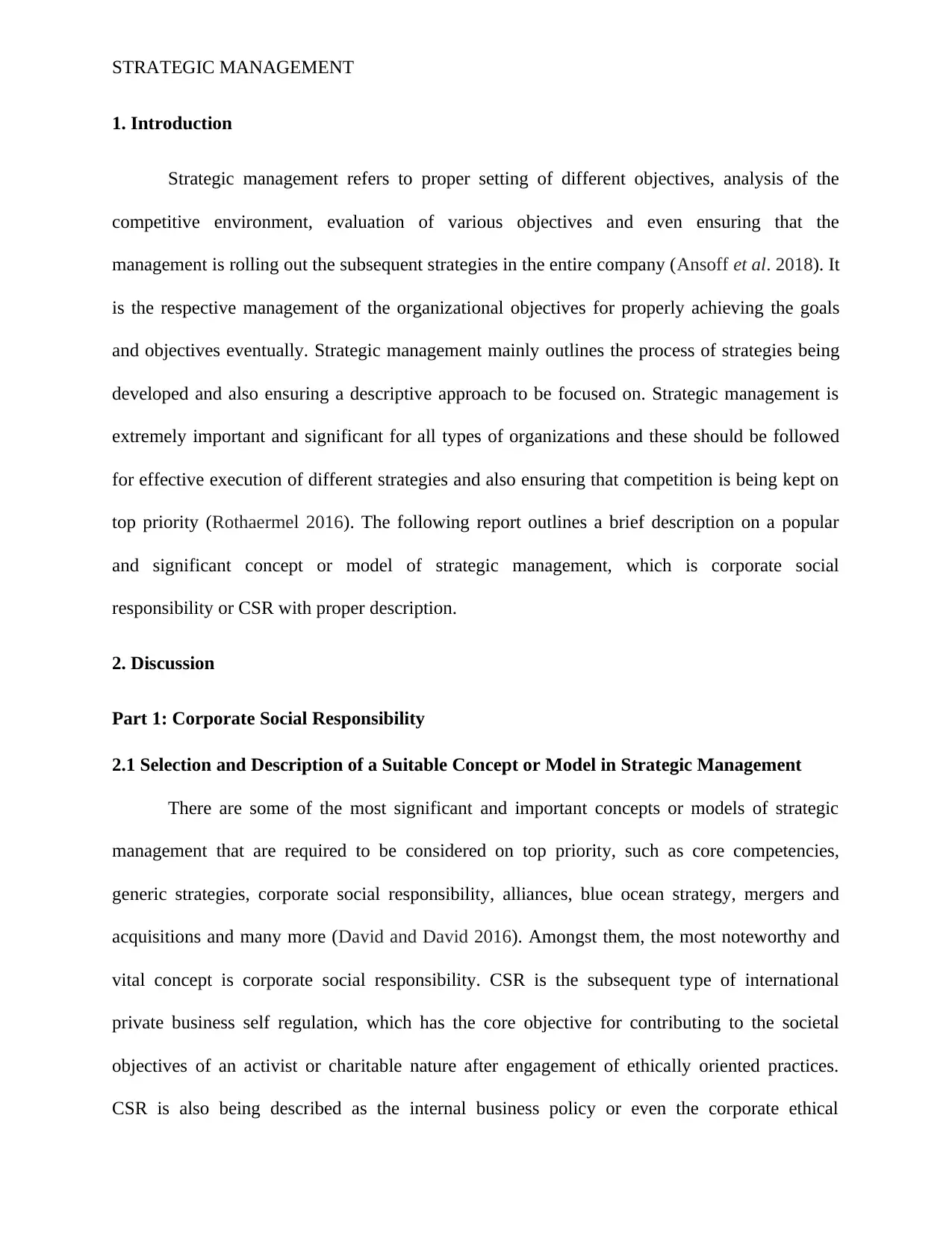
STRATEGIC MANAGEMENT
1. Introduction
Strategic management refers to proper setting of different objectives, analysis of the
competitive environment, evaluation of various objectives and even ensuring that the
management is rolling out the subsequent strategies in the entire company (Ansoff et al. 2018). It
is the respective management of the organizational objectives for properly achieving the goals
and objectives eventually. Strategic management mainly outlines the process of strategies being
developed and also ensuring a descriptive approach to be focused on. Strategic management is
extremely important and significant for all types of organizations and these should be followed
for effective execution of different strategies and also ensuring that competition is being kept on
top priority (Rothaermel 2016). The following report outlines a brief description on a popular
and significant concept or model of strategic management, which is corporate social
responsibility or CSR with proper description.
2. Discussion
Part 1: Corporate Social Responsibility
2.1 Selection and Description of a Suitable Concept or Model in Strategic Management
There are some of the most significant and important concepts or models of strategic
management that are required to be considered on top priority, such as core competencies,
generic strategies, corporate social responsibility, alliances, blue ocean strategy, mergers and
acquisitions and many more (David and David 2016). Amongst them, the most noteworthy and
vital concept is corporate social responsibility. CSR is the subsequent type of international
private business self regulation, which has the core objective for contributing to the societal
objectives of an activist or charitable nature after engagement of ethically oriented practices.
CSR is also being described as the internal business policy or even the corporate ethical
1. Introduction
Strategic management refers to proper setting of different objectives, analysis of the
competitive environment, evaluation of various objectives and even ensuring that the
management is rolling out the subsequent strategies in the entire company (Ansoff et al. 2018). It
is the respective management of the organizational objectives for properly achieving the goals
and objectives eventually. Strategic management mainly outlines the process of strategies being
developed and also ensuring a descriptive approach to be focused on. Strategic management is
extremely important and significant for all types of organizations and these should be followed
for effective execution of different strategies and also ensuring that competition is being kept on
top priority (Rothaermel 2016). The following report outlines a brief description on a popular
and significant concept or model of strategic management, which is corporate social
responsibility or CSR with proper description.
2. Discussion
Part 1: Corporate Social Responsibility
2.1 Selection and Description of a Suitable Concept or Model in Strategic Management
There are some of the most significant and important concepts or models of strategic
management that are required to be considered on top priority, such as core competencies,
generic strategies, corporate social responsibility, alliances, blue ocean strategy, mergers and
acquisitions and many more (David and David 2016). Amongst them, the most noteworthy and
vital concept is corporate social responsibility. CSR is the subsequent type of international
private business self regulation, which has the core objective for contributing to the societal
objectives of an activist or charitable nature after engagement of ethically oriented practices.
CSR is also being described as the internal business policy or even the corporate ethical
Paraphrase This Document
Need a fresh take? Get an instant paraphrase of this document with our AI Paraphraser
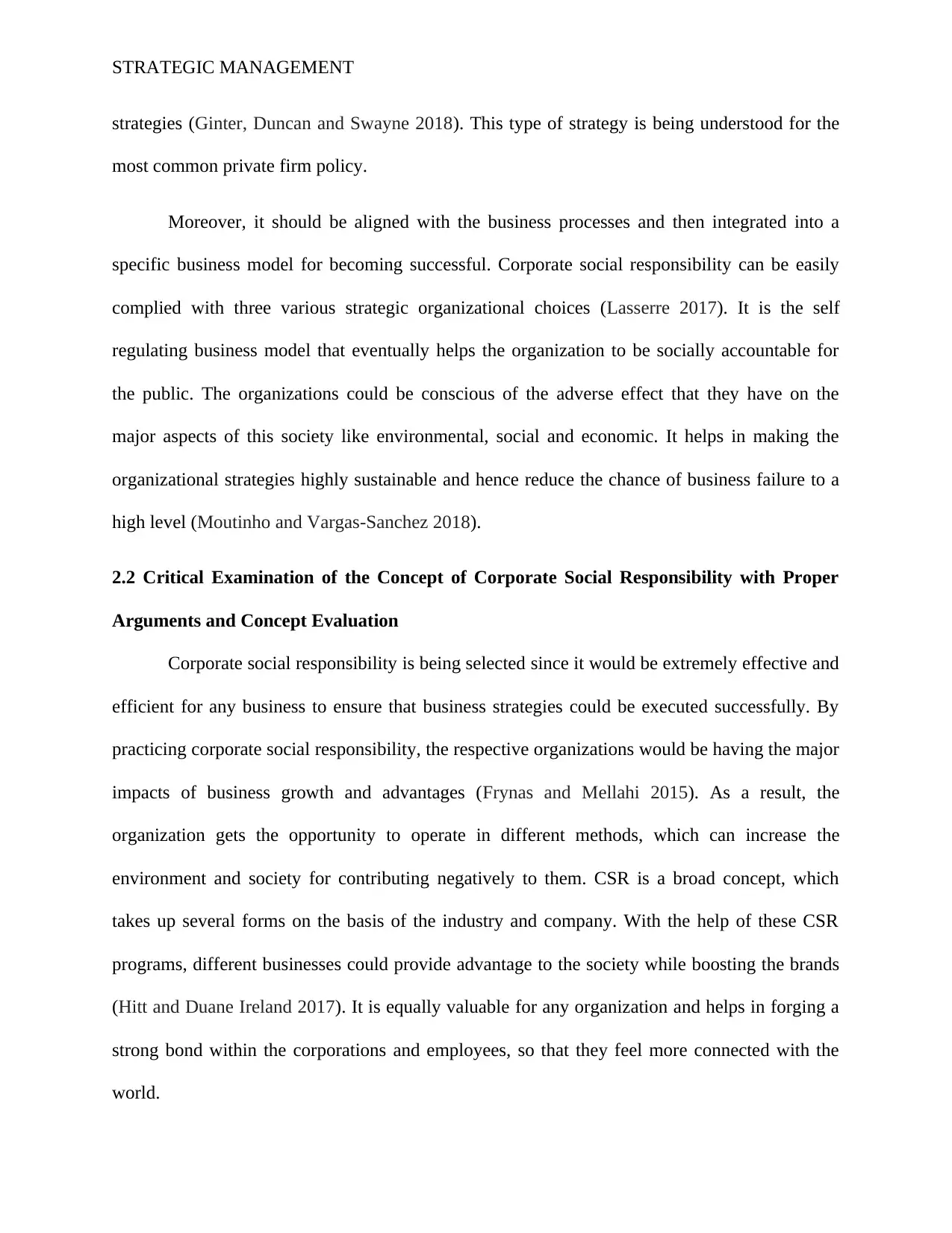
STRATEGIC MANAGEMENT
strategies (Ginter, Duncan and Swayne 2018). This type of strategy is being understood for the
most common private firm policy.
Moreover, it should be aligned with the business processes and then integrated into a
specific business model for becoming successful. Corporate social responsibility can be easily
complied with three various strategic organizational choices (Lasserre 2017). It is the self
regulating business model that eventually helps the organization to be socially accountable for
the public. The organizations could be conscious of the adverse effect that they have on the
major aspects of this society like environmental, social and economic. It helps in making the
organizational strategies highly sustainable and hence reduce the chance of business failure to a
high level (Moutinho and Vargas-Sanchez 2018).
2.2 Critical Examination of the Concept of Corporate Social Responsibility with Proper
Arguments and Concept Evaluation
Corporate social responsibility is being selected since it would be extremely effective and
efficient for any business to ensure that business strategies could be executed successfully. By
practicing corporate social responsibility, the respective organizations would be having the major
impacts of business growth and advantages (Frynas and Mellahi 2015). As a result, the
organization gets the opportunity to operate in different methods, which can increase the
environment and society for contributing negatively to them. CSR is a broad concept, which
takes up several forms on the basis of the industry and company. With the help of these CSR
programs, different businesses could provide advantage to the society while boosting the brands
(Hitt and Duane Ireland 2017). It is equally valuable for any organization and helps in forging a
strong bond within the corporations and employees, so that they feel more connected with the
world.
strategies (Ginter, Duncan and Swayne 2018). This type of strategy is being understood for the
most common private firm policy.
Moreover, it should be aligned with the business processes and then integrated into a
specific business model for becoming successful. Corporate social responsibility can be easily
complied with three various strategic organizational choices (Lasserre 2017). It is the self
regulating business model that eventually helps the organization to be socially accountable for
the public. The organizations could be conscious of the adverse effect that they have on the
major aspects of this society like environmental, social and economic. It helps in making the
organizational strategies highly sustainable and hence reduce the chance of business failure to a
high level (Moutinho and Vargas-Sanchez 2018).
2.2 Critical Examination of the Concept of Corporate Social Responsibility with Proper
Arguments and Concept Evaluation
Corporate social responsibility is being selected since it would be extremely effective and
efficient for any business to ensure that business strategies could be executed successfully. By
practicing corporate social responsibility, the respective organizations would be having the major
impacts of business growth and advantages (Frynas and Mellahi 2015). As a result, the
organization gets the opportunity to operate in different methods, which can increase the
environment and society for contributing negatively to them. CSR is a broad concept, which
takes up several forms on the basis of the industry and company. With the help of these CSR
programs, different businesses could provide advantage to the society while boosting the brands
(Hitt and Duane Ireland 2017). It is equally valuable for any organization and helps in forging a
strong bond within the corporations and employees, so that they feel more connected with the
world.
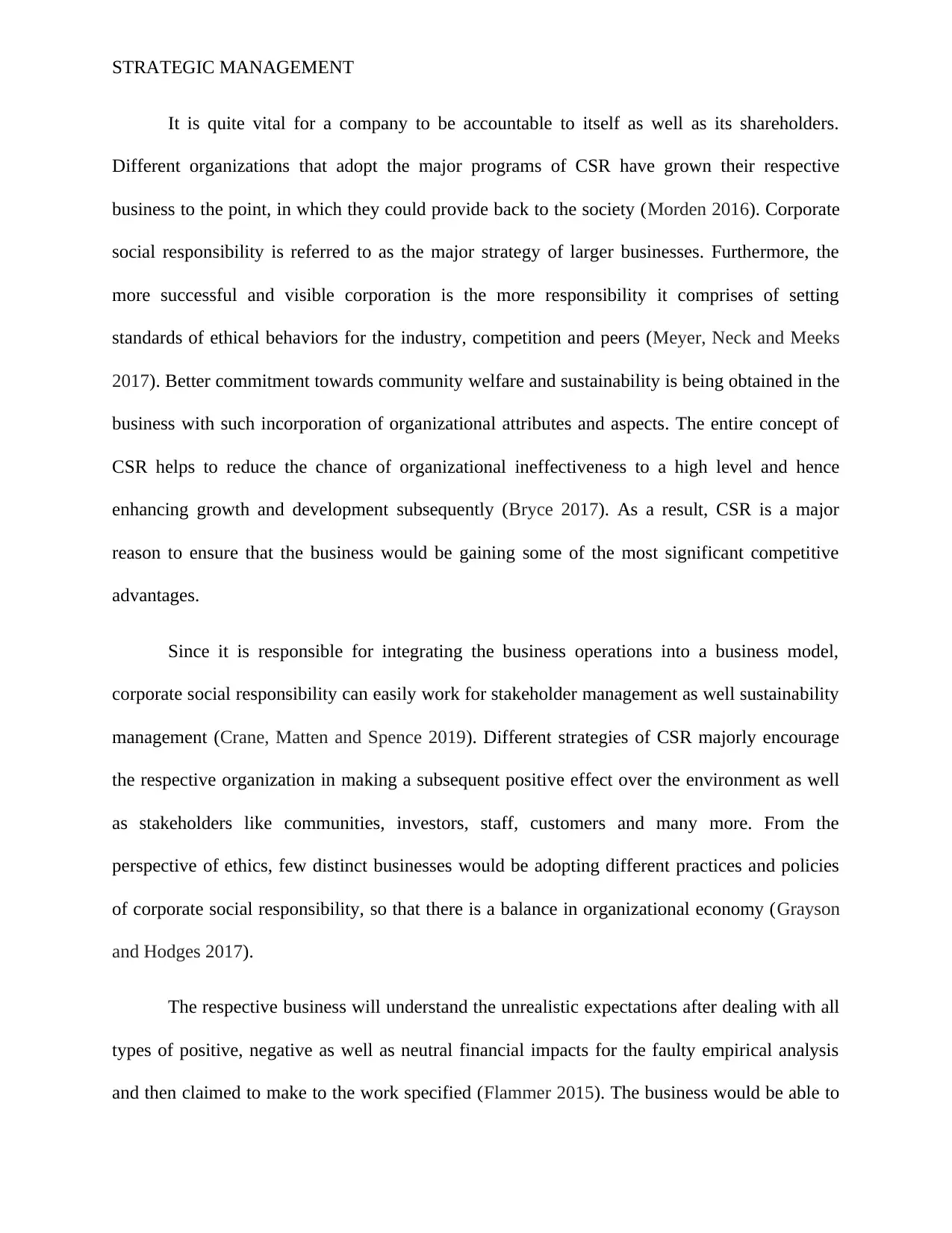
STRATEGIC MANAGEMENT
It is quite vital for a company to be accountable to itself as well as its shareholders.
Different organizations that adopt the major programs of CSR have grown their respective
business to the point, in which they could provide back to the society (Morden 2016). Corporate
social responsibility is referred to as the major strategy of larger businesses. Furthermore, the
more successful and visible corporation is the more responsibility it comprises of setting
standards of ethical behaviors for the industry, competition and peers (Meyer, Neck and Meeks
2017). Better commitment towards community welfare and sustainability is being obtained in the
business with such incorporation of organizational attributes and aspects. The entire concept of
CSR helps to reduce the chance of organizational ineffectiveness to a high level and hence
enhancing growth and development subsequently (Bryce 2017). As a result, CSR is a major
reason to ensure that the business would be gaining some of the most significant competitive
advantages.
Since it is responsible for integrating the business operations into a business model,
corporate social responsibility can easily work for stakeholder management as well sustainability
management (Crane, Matten and Spence 2019). Different strategies of CSR majorly encourage
the respective organization in making a subsequent positive effect over the environment as well
as stakeholders like communities, investors, staff, customers and many more. From the
perspective of ethics, few distinct businesses would be adopting different practices and policies
of corporate social responsibility, so that there is a balance in organizational economy (Grayson
and Hodges 2017).
The respective business will understand the unrealistic expectations after dealing with all
types of positive, negative as well as neutral financial impacts for the faulty empirical analysis
and then claimed to make to the work specified (Flammer 2015). The business would be able to
It is quite vital for a company to be accountable to itself as well as its shareholders.
Different organizations that adopt the major programs of CSR have grown their respective
business to the point, in which they could provide back to the society (Morden 2016). Corporate
social responsibility is referred to as the major strategy of larger businesses. Furthermore, the
more successful and visible corporation is the more responsibility it comprises of setting
standards of ethical behaviors for the industry, competition and peers (Meyer, Neck and Meeks
2017). Better commitment towards community welfare and sustainability is being obtained in the
business with such incorporation of organizational attributes and aspects. The entire concept of
CSR helps to reduce the chance of organizational ineffectiveness to a high level and hence
enhancing growth and development subsequently (Bryce 2017). As a result, CSR is a major
reason to ensure that the business would be gaining some of the most significant competitive
advantages.
Since it is responsible for integrating the business operations into a business model,
corporate social responsibility can easily work for stakeholder management as well sustainability
management (Crane, Matten and Spence 2019). Different strategies of CSR majorly encourage
the respective organization in making a subsequent positive effect over the environment as well
as stakeholders like communities, investors, staff, customers and many more. From the
perspective of ethics, few distinct businesses would be adopting different practices and policies
of corporate social responsibility, so that there is a balance in organizational economy (Grayson
and Hodges 2017).
The respective business will understand the unrealistic expectations after dealing with all
types of positive, negative as well as neutral financial impacts for the faulty empirical analysis
and then claimed to make to the work specified (Flammer 2015). The business would be able to
⊘ This is a preview!⊘
Do you want full access?
Subscribe today to unlock all pages.

Trusted by 1+ million students worldwide
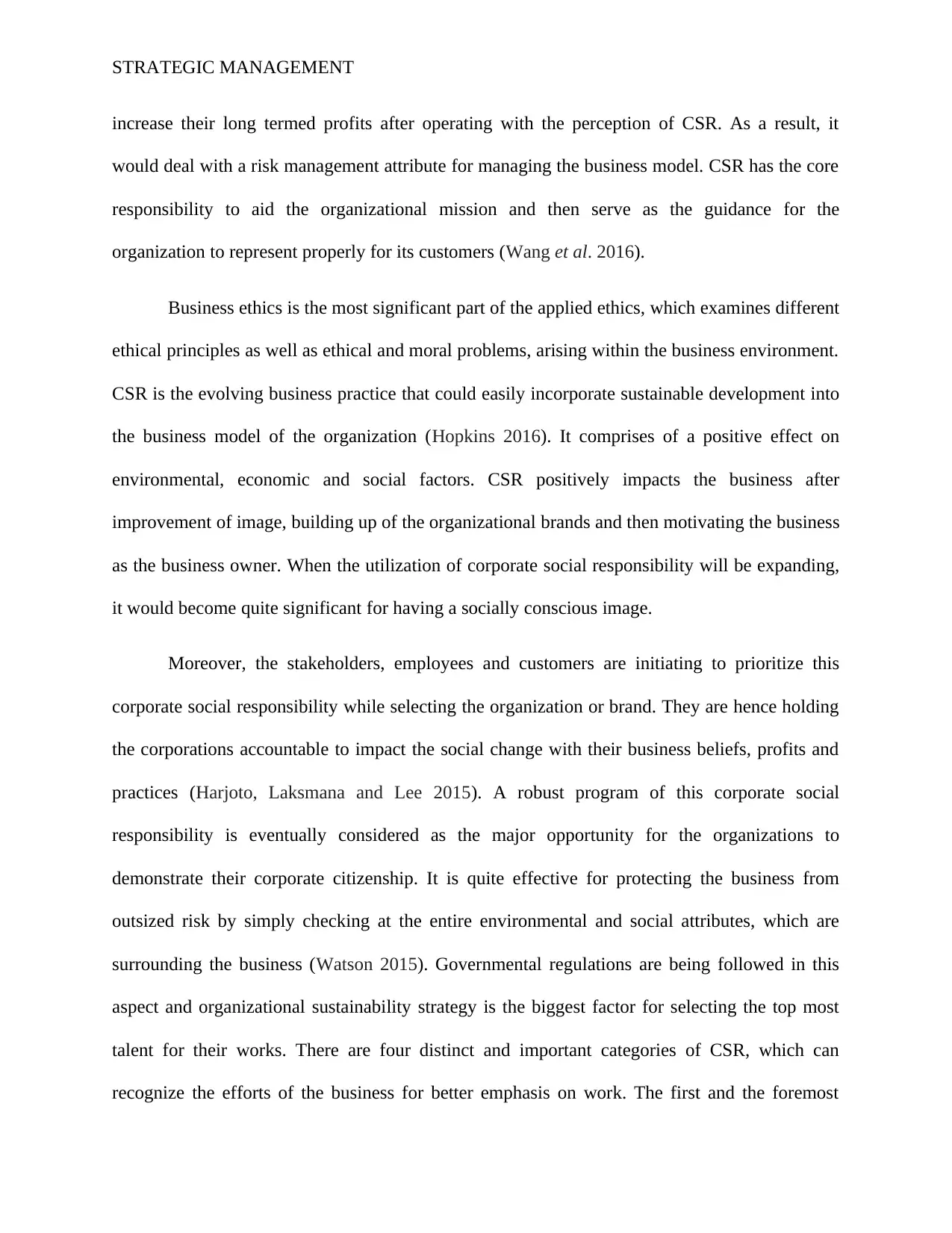
STRATEGIC MANAGEMENT
increase their long termed profits after operating with the perception of CSR. As a result, it
would deal with a risk management attribute for managing the business model. CSR has the core
responsibility to aid the organizational mission and then serve as the guidance for the
organization to represent properly for its customers (Wang et al. 2016).
Business ethics is the most significant part of the applied ethics, which examines different
ethical principles as well as ethical and moral problems, arising within the business environment.
CSR is the evolving business practice that could easily incorporate sustainable development into
the business model of the organization (Hopkins 2016). It comprises of a positive effect on
environmental, economic and social factors. CSR positively impacts the business after
improvement of image, building up of the organizational brands and then motivating the business
as the business owner. When the utilization of corporate social responsibility will be expanding,
it would become quite significant for having a socially conscious image.
Moreover, the stakeholders, employees and customers are initiating to prioritize this
corporate social responsibility while selecting the organization or brand. They are hence holding
the corporations accountable to impact the social change with their business beliefs, profits and
practices (Harjoto, Laksmana and Lee 2015). A robust program of this corporate social
responsibility is eventually considered as the major opportunity for the organizations to
demonstrate their corporate citizenship. It is quite effective for protecting the business from
outsized risk by simply checking at the entire environmental and social attributes, which are
surrounding the business (Watson 2015). Governmental regulations are being followed in this
aspect and organizational sustainability strategy is the biggest factor for selecting the top most
talent for their works. There are four distinct and important categories of CSR, which can
recognize the efforts of the business for better emphasis on work. The first and the foremost
increase their long termed profits after operating with the perception of CSR. As a result, it
would deal with a risk management attribute for managing the business model. CSR has the core
responsibility to aid the organizational mission and then serve as the guidance for the
organization to represent properly for its customers (Wang et al. 2016).
Business ethics is the most significant part of the applied ethics, which examines different
ethical principles as well as ethical and moral problems, arising within the business environment.
CSR is the evolving business practice that could easily incorporate sustainable development into
the business model of the organization (Hopkins 2016). It comprises of a positive effect on
environmental, economic and social factors. CSR positively impacts the business after
improvement of image, building up of the organizational brands and then motivating the business
as the business owner. When the utilization of corporate social responsibility will be expanding,
it would become quite significant for having a socially conscious image.
Moreover, the stakeholders, employees and customers are initiating to prioritize this
corporate social responsibility while selecting the organization or brand. They are hence holding
the corporations accountable to impact the social change with their business beliefs, profits and
practices (Harjoto, Laksmana and Lee 2015). A robust program of this corporate social
responsibility is eventually considered as the major opportunity for the organizations to
demonstrate their corporate citizenship. It is quite effective for protecting the business from
outsized risk by simply checking at the entire environmental and social attributes, which are
surrounding the business (Watson 2015). Governmental regulations are being followed in this
aspect and organizational sustainability strategy is the biggest factor for selecting the top most
talent for their works. There are four distinct and important categories of CSR, which can
recognize the efforts of the business for better emphasis on work. The first and the foremost
Paraphrase This Document
Need a fresh take? Get an instant paraphrase of this document with our AI Paraphraser
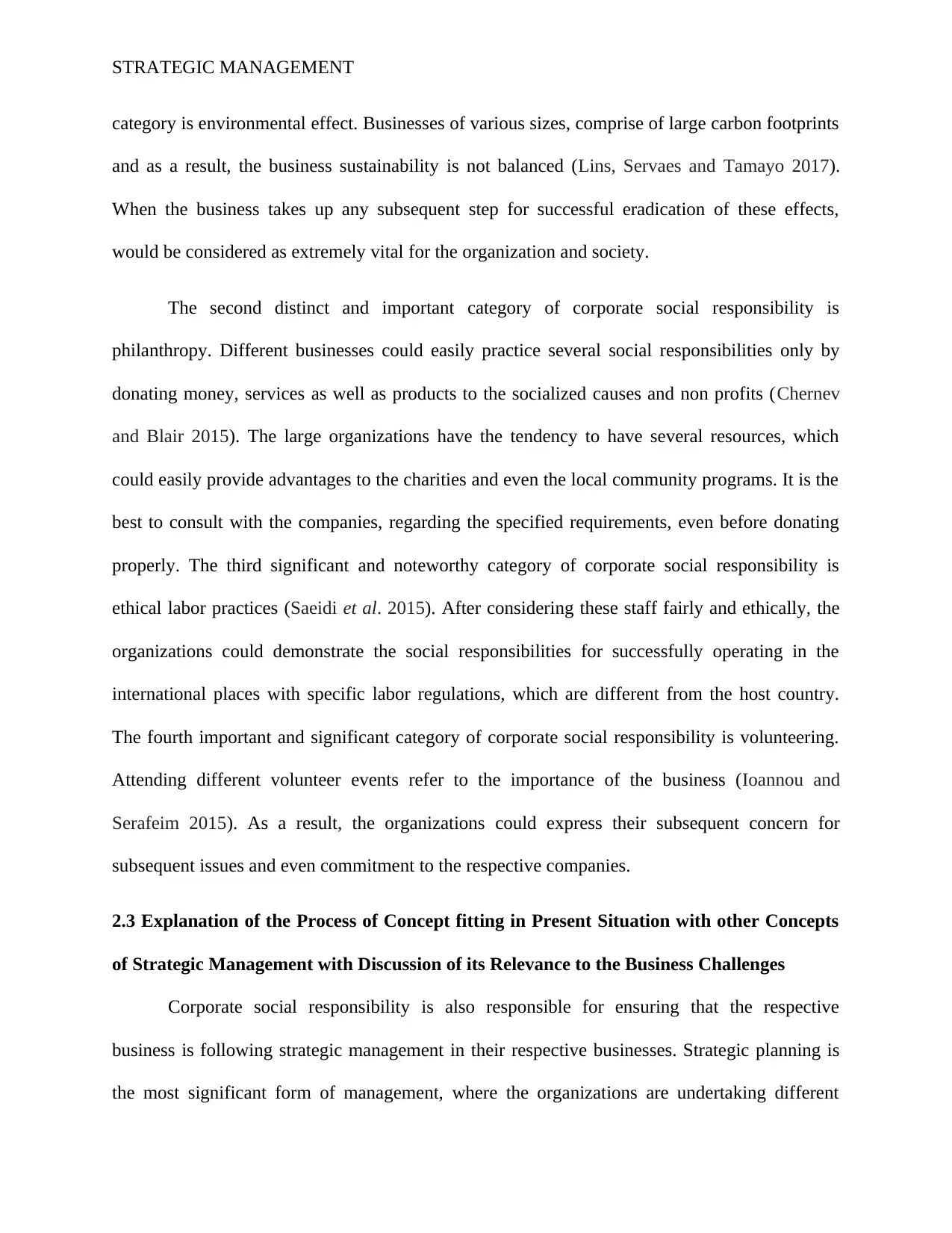
STRATEGIC MANAGEMENT
category is environmental effect. Businesses of various sizes, comprise of large carbon footprints
and as a result, the business sustainability is not balanced (Lins, Servaes and Tamayo 2017).
When the business takes up any subsequent step for successful eradication of these effects,
would be considered as extremely vital for the organization and society.
The second distinct and important category of corporate social responsibility is
philanthropy. Different businesses could easily practice several social responsibilities only by
donating money, services as well as products to the socialized causes and non profits (Chernev
and Blair 2015). The large organizations have the tendency to have several resources, which
could easily provide advantages to the charities and even the local community programs. It is the
best to consult with the companies, regarding the specified requirements, even before donating
properly. The third significant and noteworthy category of corporate social responsibility is
ethical labor practices (Saeidi et al. 2015). After considering these staff fairly and ethically, the
organizations could demonstrate the social responsibilities for successfully operating in the
international places with specific labor regulations, which are different from the host country.
The fourth important and significant category of corporate social responsibility is volunteering.
Attending different volunteer events refer to the importance of the business (Ioannou and
Serafeim 2015). As a result, the organizations could express their subsequent concern for
subsequent issues and even commitment to the respective companies.
2.3 Explanation of the Process of Concept fitting in Present Situation with other Concepts
of Strategic Management with Discussion of its Relevance to the Business Challenges
Corporate social responsibility is also responsible for ensuring that the respective
business is following strategic management in their respective businesses. Strategic planning is
the most significant form of management, where the organizations are undertaking different
category is environmental effect. Businesses of various sizes, comprise of large carbon footprints
and as a result, the business sustainability is not balanced (Lins, Servaes and Tamayo 2017).
When the business takes up any subsequent step for successful eradication of these effects,
would be considered as extremely vital for the organization and society.
The second distinct and important category of corporate social responsibility is
philanthropy. Different businesses could easily practice several social responsibilities only by
donating money, services as well as products to the socialized causes and non profits (Chernev
and Blair 2015). The large organizations have the tendency to have several resources, which
could easily provide advantages to the charities and even the local community programs. It is the
best to consult with the companies, regarding the specified requirements, even before donating
properly. The third significant and noteworthy category of corporate social responsibility is
ethical labor practices (Saeidi et al. 2015). After considering these staff fairly and ethically, the
organizations could demonstrate the social responsibilities for successfully operating in the
international places with specific labor regulations, which are different from the host country.
The fourth important and significant category of corporate social responsibility is volunteering.
Attending different volunteer events refer to the importance of the business (Ioannou and
Serafeim 2015). As a result, the organizations could express their subsequent concern for
subsequent issues and even commitment to the respective companies.
2.3 Explanation of the Process of Concept fitting in Present Situation with other Concepts
of Strategic Management with Discussion of its Relevance to the Business Challenges
Corporate social responsibility is also responsible for ensuring that the respective
business is following strategic management in their respective businesses. Strategic planning is
the most significant form of management, where the organizations are undertaking different
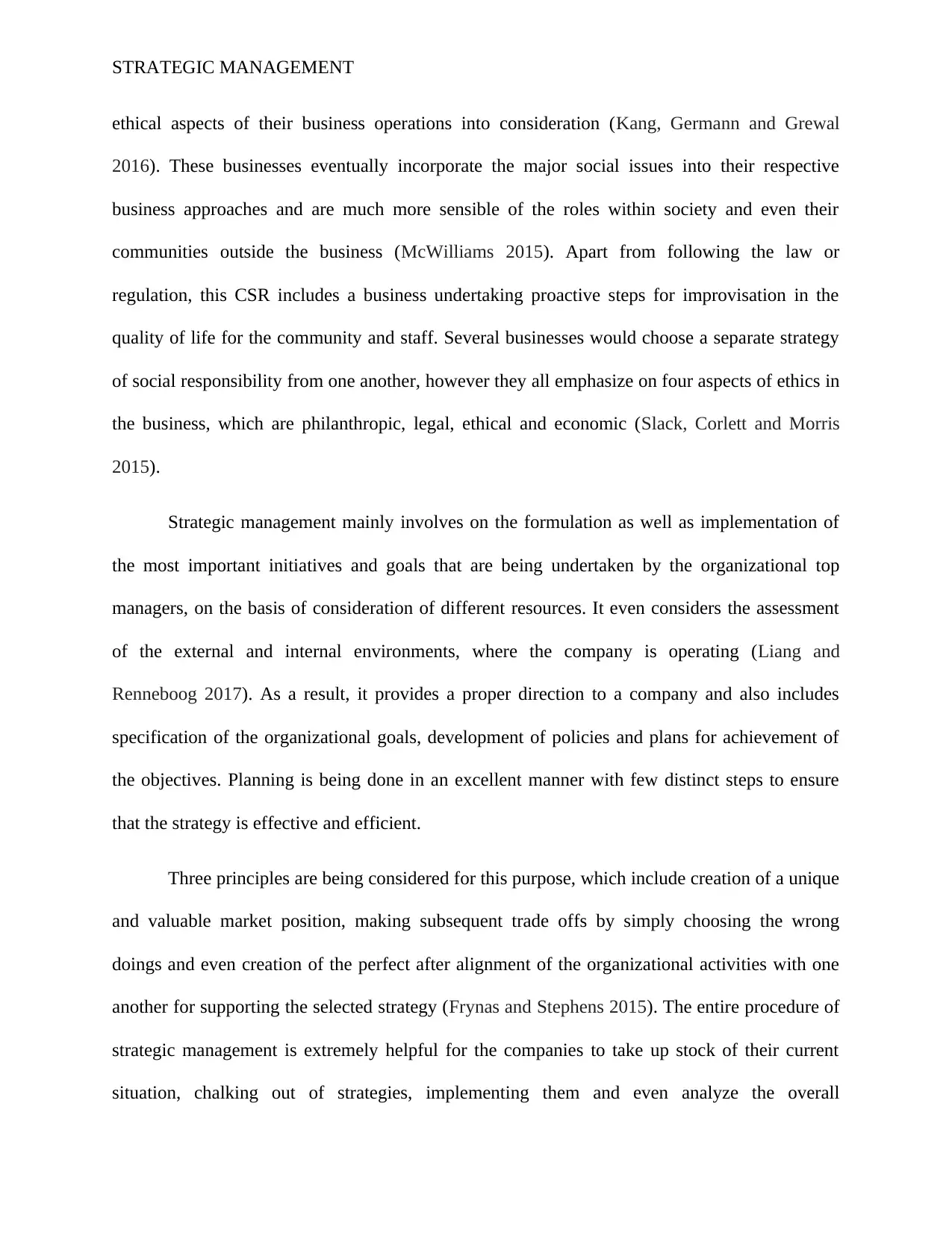
STRATEGIC MANAGEMENT
ethical aspects of their business operations into consideration (Kang, Germann and Grewal
2016). These businesses eventually incorporate the major social issues into their respective
business approaches and are much more sensible of the roles within society and even their
communities outside the business (McWilliams 2015). Apart from following the law or
regulation, this CSR includes a business undertaking proactive steps for improvisation in the
quality of life for the community and staff. Several businesses would choose a separate strategy
of social responsibility from one another, however they all emphasize on four aspects of ethics in
the business, which are philanthropic, legal, ethical and economic (Slack, Corlett and Morris
2015).
Strategic management mainly involves on the formulation as well as implementation of
the most important initiatives and goals that are being undertaken by the organizational top
managers, on the basis of consideration of different resources. It even considers the assessment
of the external and internal environments, where the company is operating (Liang and
Renneboog 2017). As a result, it provides a proper direction to a company and also includes
specification of the organizational goals, development of policies and plans for achievement of
the objectives. Planning is being done in an excellent manner with few distinct steps to ensure
that the strategy is effective and efficient.
Three principles are being considered for this purpose, which include creation of a unique
and valuable market position, making subsequent trade offs by simply choosing the wrong
doings and even creation of the perfect after alignment of the organizational activities with one
another for supporting the selected strategy (Frynas and Stephens 2015). The entire procedure of
strategic management is extremely helpful for the companies to take up stock of their current
situation, chalking out of strategies, implementing them and even analyze the overall
ethical aspects of their business operations into consideration (Kang, Germann and Grewal
2016). These businesses eventually incorporate the major social issues into their respective
business approaches and are much more sensible of the roles within society and even their
communities outside the business (McWilliams 2015). Apart from following the law or
regulation, this CSR includes a business undertaking proactive steps for improvisation in the
quality of life for the community and staff. Several businesses would choose a separate strategy
of social responsibility from one another, however they all emphasize on four aspects of ethics in
the business, which are philanthropic, legal, ethical and economic (Slack, Corlett and Morris
2015).
Strategic management mainly involves on the formulation as well as implementation of
the most important initiatives and goals that are being undertaken by the organizational top
managers, on the basis of consideration of different resources. It even considers the assessment
of the external and internal environments, where the company is operating (Liang and
Renneboog 2017). As a result, it provides a proper direction to a company and also includes
specification of the organizational goals, development of policies and plans for achievement of
the objectives. Planning is being done in an excellent manner with few distinct steps to ensure
that the strategy is effective and efficient.
Three principles are being considered for this purpose, which include creation of a unique
and valuable market position, making subsequent trade offs by simply choosing the wrong
doings and even creation of the perfect after alignment of the organizational activities with one
another for supporting the selected strategy (Frynas and Stephens 2015). The entire procedure of
strategic management is extremely helpful for the companies to take up stock of their current
situation, chalking out of strategies, implementing them and even analyze the overall
⊘ This is a preview!⊘
Do you want full access?
Subscribe today to unlock all pages.

Trusted by 1+ million students worldwide
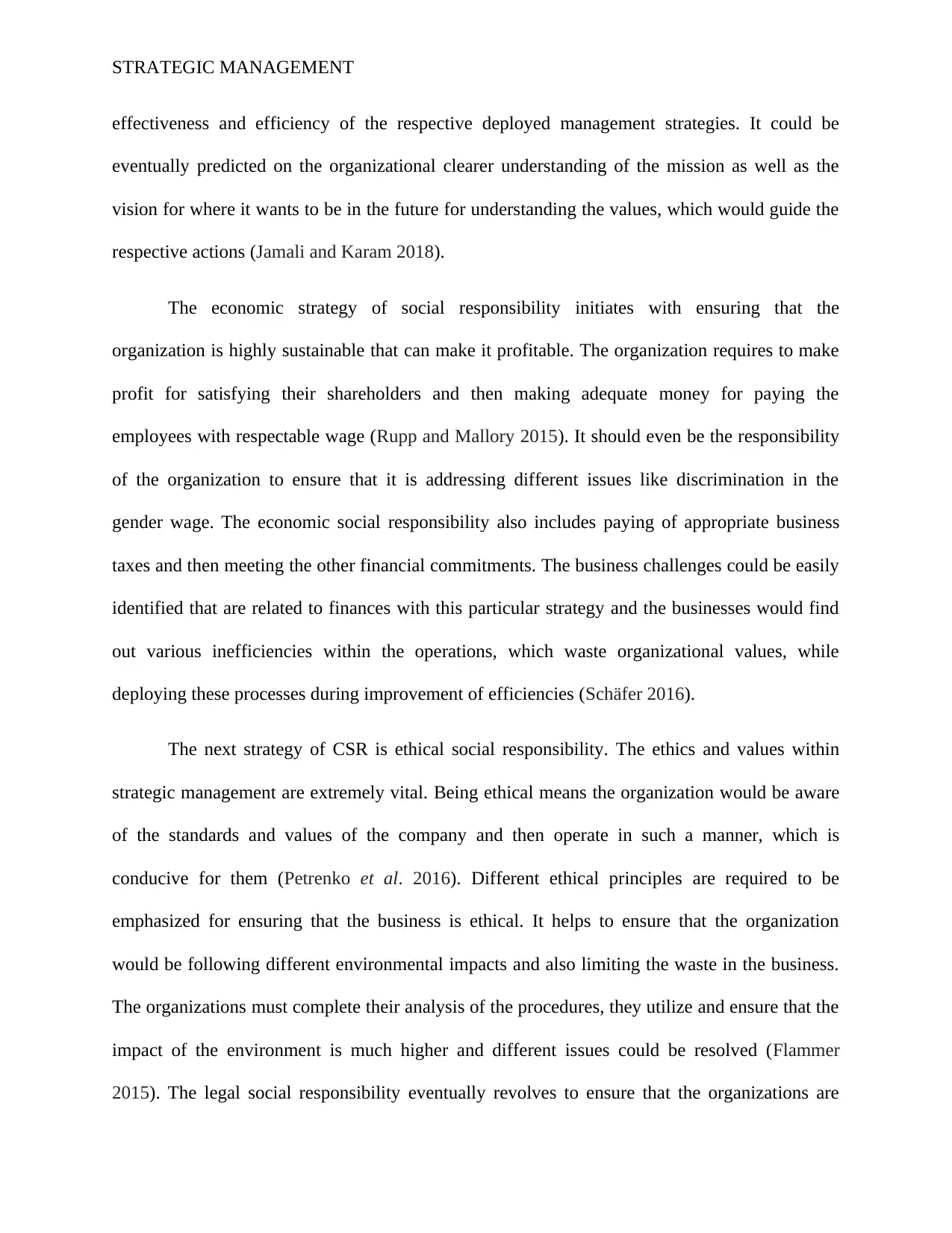
STRATEGIC MANAGEMENT
effectiveness and efficiency of the respective deployed management strategies. It could be
eventually predicted on the organizational clearer understanding of the mission as well as the
vision for where it wants to be in the future for understanding the values, which would guide the
respective actions (Jamali and Karam 2018).
The economic strategy of social responsibility initiates with ensuring that the
organization is highly sustainable that can make it profitable. The organization requires to make
profit for satisfying their shareholders and then making adequate money for paying the
employees with respectable wage (Rupp and Mallory 2015). It should even be the responsibility
of the organization to ensure that it is addressing different issues like discrimination in the
gender wage. The economic social responsibility also includes paying of appropriate business
taxes and then meeting the other financial commitments. The business challenges could be easily
identified that are related to finances with this particular strategy and the businesses would find
out various inefficiencies within the operations, which waste organizational values, while
deploying these processes during improvement of efficiencies (Schäfer 2016).
The next strategy of CSR is ethical social responsibility. The ethics and values within
strategic management are extremely vital. Being ethical means the organization would be aware
of the standards and values of the company and then operate in such a manner, which is
conducive for them (Petrenko et al. 2016). Different ethical principles are required to be
emphasized for ensuring that the business is ethical. It helps to ensure that the organization
would be following different environmental impacts and also limiting the waste in the business.
The organizations must complete their analysis of the procedures, they utilize and ensure that the
impact of the environment is much higher and different issues could be resolved (Flammer
2015). The legal social responsibility eventually revolves to ensure that the organizations are
effectiveness and efficiency of the respective deployed management strategies. It could be
eventually predicted on the organizational clearer understanding of the mission as well as the
vision for where it wants to be in the future for understanding the values, which would guide the
respective actions (Jamali and Karam 2018).
The economic strategy of social responsibility initiates with ensuring that the
organization is highly sustainable that can make it profitable. The organization requires to make
profit for satisfying their shareholders and then making adequate money for paying the
employees with respectable wage (Rupp and Mallory 2015). It should even be the responsibility
of the organization to ensure that it is addressing different issues like discrimination in the
gender wage. The economic social responsibility also includes paying of appropriate business
taxes and then meeting the other financial commitments. The business challenges could be easily
identified that are related to finances with this particular strategy and the businesses would find
out various inefficiencies within the operations, which waste organizational values, while
deploying these processes during improvement of efficiencies (Schäfer 2016).
The next strategy of CSR is ethical social responsibility. The ethics and values within
strategic management are extremely vital. Being ethical means the organization would be aware
of the standards and values of the company and then operate in such a manner, which is
conducive for them (Petrenko et al. 2016). Different ethical principles are required to be
emphasized for ensuring that the business is ethical. It helps to ensure that the organization
would be following different environmental impacts and also limiting the waste in the business.
The organizations must complete their analysis of the procedures, they utilize and ensure that the
impact of the environment is much higher and different issues could be resolved (Flammer
2015). The legal social responsibility eventually revolves to ensure that the organizations are
Paraphrase This Document
Need a fresh take? Get an instant paraphrase of this document with our AI Paraphraser
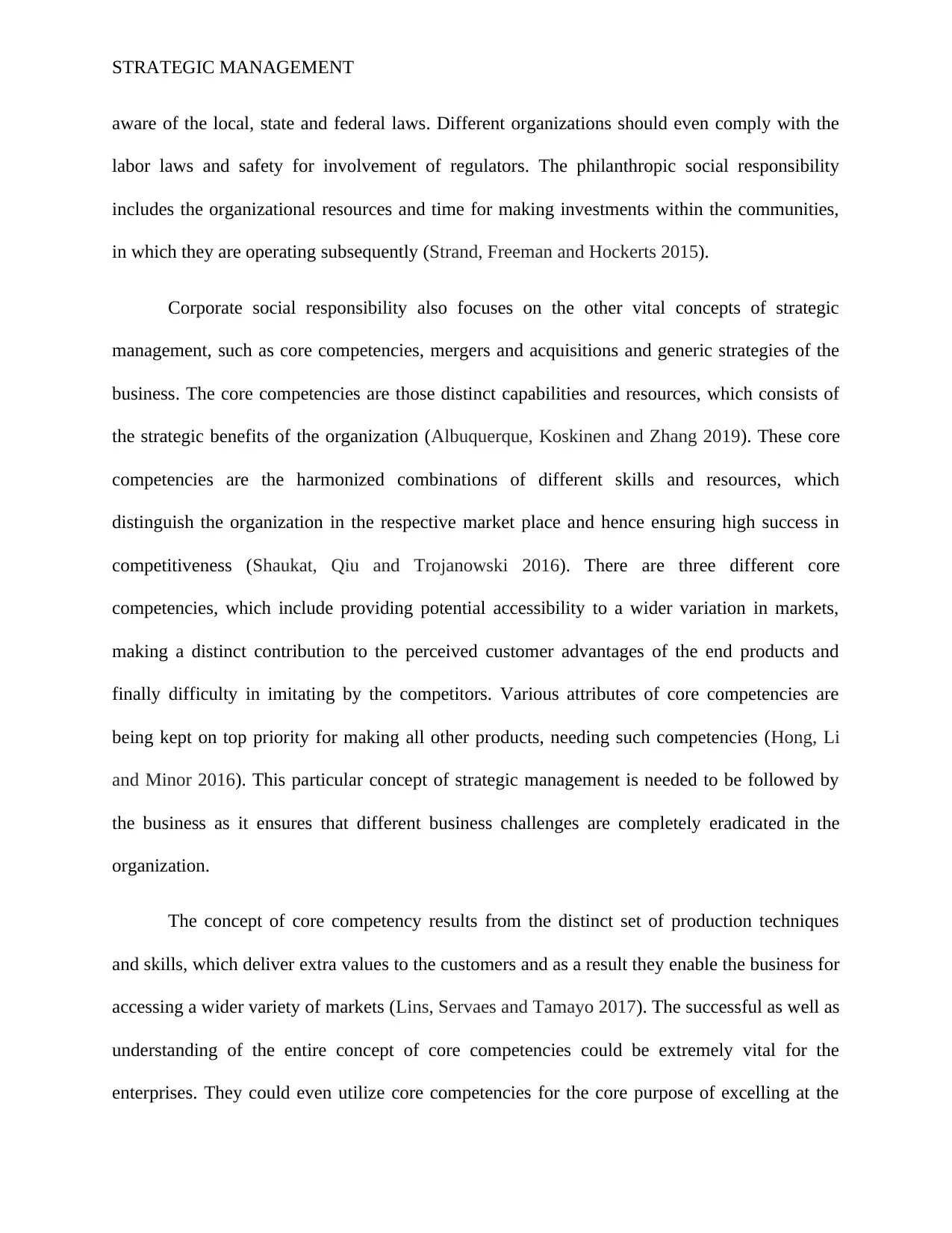
STRATEGIC MANAGEMENT
aware of the local, state and federal laws. Different organizations should even comply with the
labor laws and safety for involvement of regulators. The philanthropic social responsibility
includes the organizational resources and time for making investments within the communities,
in which they are operating subsequently (Strand, Freeman and Hockerts 2015).
Corporate social responsibility also focuses on the other vital concepts of strategic
management, such as core competencies, mergers and acquisitions and generic strategies of the
business. The core competencies are those distinct capabilities and resources, which consists of
the strategic benefits of the organization (Albuquerque, Koskinen and Zhang 2019). These core
competencies are the harmonized combinations of different skills and resources, which
distinguish the organization in the respective market place and hence ensuring high success in
competitiveness (Shaukat, Qiu and Trojanowski 2016). There are three different core
competencies, which include providing potential accessibility to a wider variation in markets,
making a distinct contribution to the perceived customer advantages of the end products and
finally difficulty in imitating by the competitors. Various attributes of core competencies are
being kept on top priority for making all other products, needing such competencies (Hong, Li
and Minor 2016). This particular concept of strategic management is needed to be followed by
the business as it ensures that different business challenges are completely eradicated in the
organization.
The concept of core competency results from the distinct set of production techniques
and skills, which deliver extra values to the customers and as a result they enable the business for
accessing a wider variety of markets (Lins, Servaes and Tamayo 2017). The successful as well as
understanding of the entire concept of core competencies could be extremely vital for the
enterprises. They could even utilize core competencies for the core purpose of excelling at the
aware of the local, state and federal laws. Different organizations should even comply with the
labor laws and safety for involvement of regulators. The philanthropic social responsibility
includes the organizational resources and time for making investments within the communities,
in which they are operating subsequently (Strand, Freeman and Hockerts 2015).
Corporate social responsibility also focuses on the other vital concepts of strategic
management, such as core competencies, mergers and acquisitions and generic strategies of the
business. The core competencies are those distinct capabilities and resources, which consists of
the strategic benefits of the organization (Albuquerque, Koskinen and Zhang 2019). These core
competencies are the harmonized combinations of different skills and resources, which
distinguish the organization in the respective market place and hence ensuring high success in
competitiveness (Shaukat, Qiu and Trojanowski 2016). There are three different core
competencies, which include providing potential accessibility to a wider variation in markets,
making a distinct contribution to the perceived customer advantages of the end products and
finally difficulty in imitating by the competitors. Various attributes of core competencies are
being kept on top priority for making all other products, needing such competencies (Hong, Li
and Minor 2016). This particular concept of strategic management is needed to be followed by
the business as it ensures that different business challenges are completely eradicated in the
organization.
The concept of core competency results from the distinct set of production techniques
and skills, which deliver extra values to the customers and as a result they enable the business for
accessing a wider variety of markets (Lins, Servaes and Tamayo 2017). The successful as well as
understanding of the entire concept of core competencies could be extremely vital for the
enterprises. They could even utilize core competencies for the core purpose of excelling at the
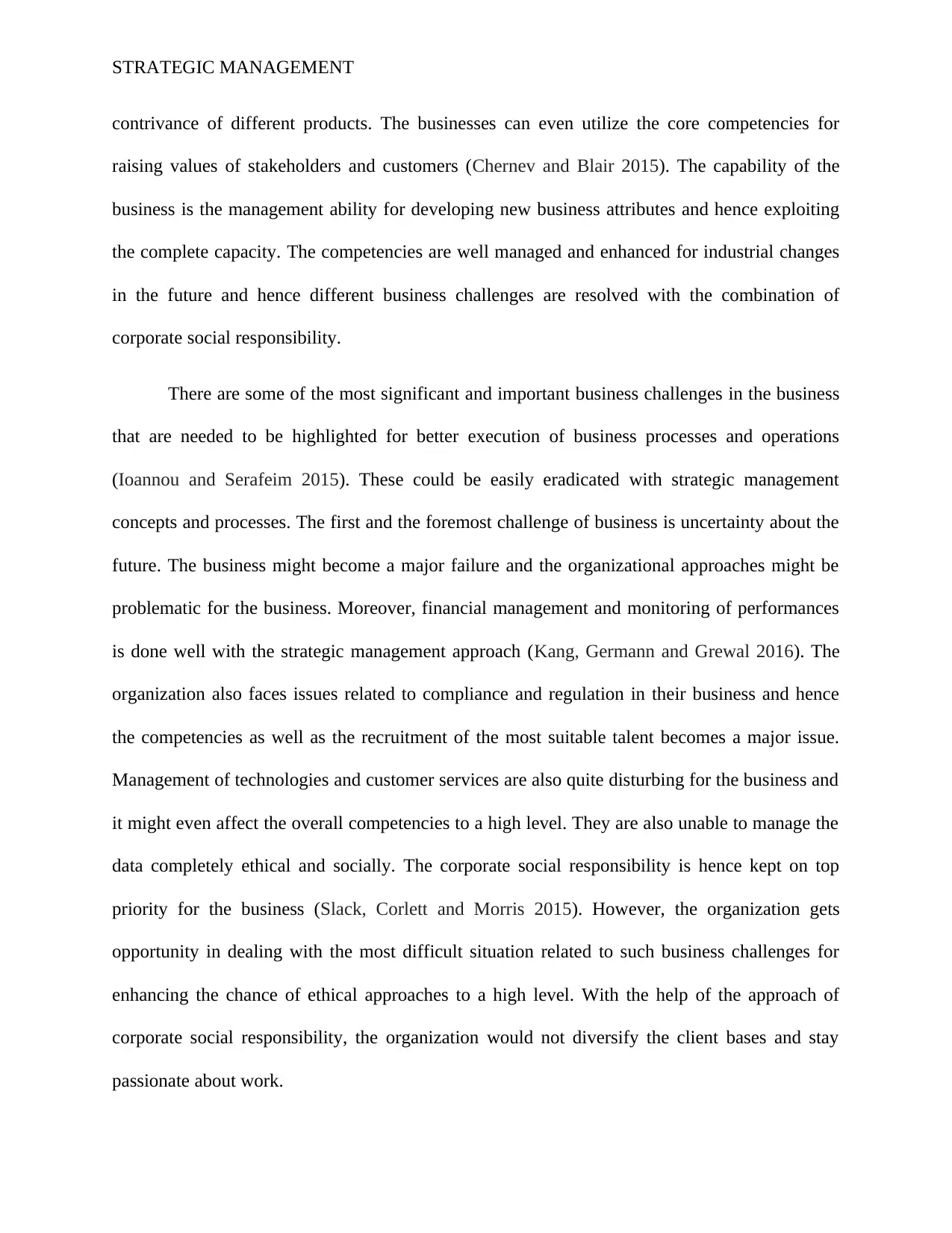
STRATEGIC MANAGEMENT
contrivance of different products. The businesses can even utilize the core competencies for
raising values of stakeholders and customers (Chernev and Blair 2015). The capability of the
business is the management ability for developing new business attributes and hence exploiting
the complete capacity. The competencies are well managed and enhanced for industrial changes
in the future and hence different business challenges are resolved with the combination of
corporate social responsibility.
There are some of the most significant and important business challenges in the business
that are needed to be highlighted for better execution of business processes and operations
(Ioannou and Serafeim 2015). These could be easily eradicated with strategic management
concepts and processes. The first and the foremost challenge of business is uncertainty about the
future. The business might become a major failure and the organizational approaches might be
problematic for the business. Moreover, financial management and monitoring of performances
is done well with the strategic management approach (Kang, Germann and Grewal 2016). The
organization also faces issues related to compliance and regulation in their business and hence
the competencies as well as the recruitment of the most suitable talent becomes a major issue.
Management of technologies and customer services are also quite disturbing for the business and
it might even affect the overall competencies to a high level. They are also unable to manage the
data completely ethical and socially. The corporate social responsibility is hence kept on top
priority for the business (Slack, Corlett and Morris 2015). However, the organization gets
opportunity in dealing with the most difficult situation related to such business challenges for
enhancing the chance of ethical approaches to a high level. With the help of the approach of
corporate social responsibility, the organization would not diversify the client bases and stay
passionate about work.
contrivance of different products. The businesses can even utilize the core competencies for
raising values of stakeholders and customers (Chernev and Blair 2015). The capability of the
business is the management ability for developing new business attributes and hence exploiting
the complete capacity. The competencies are well managed and enhanced for industrial changes
in the future and hence different business challenges are resolved with the combination of
corporate social responsibility.
There are some of the most significant and important business challenges in the business
that are needed to be highlighted for better execution of business processes and operations
(Ioannou and Serafeim 2015). These could be easily eradicated with strategic management
concepts and processes. The first and the foremost challenge of business is uncertainty about the
future. The business might become a major failure and the organizational approaches might be
problematic for the business. Moreover, financial management and monitoring of performances
is done well with the strategic management approach (Kang, Germann and Grewal 2016). The
organization also faces issues related to compliance and regulation in their business and hence
the competencies as well as the recruitment of the most suitable talent becomes a major issue.
Management of technologies and customer services are also quite disturbing for the business and
it might even affect the overall competencies to a high level. They are also unable to manage the
data completely ethical and socially. The corporate social responsibility is hence kept on top
priority for the business (Slack, Corlett and Morris 2015). However, the organization gets
opportunity in dealing with the most difficult situation related to such business challenges for
enhancing the chance of ethical approaches to a high level. With the help of the approach of
corporate social responsibility, the organization would not diversify the client bases and stay
passionate about work.
⊘ This is a preview!⊘
Do you want full access?
Subscribe today to unlock all pages.

Trusted by 1+ million students worldwide
1 out of 23
Related Documents
Your All-in-One AI-Powered Toolkit for Academic Success.
+13062052269
info@desklib.com
Available 24*7 on WhatsApp / Email
![[object Object]](/_next/static/media/star-bottom.7253800d.svg)
Unlock your academic potential
Copyright © 2020–2025 A2Z Services. All Rights Reserved. Developed and managed by ZUCOL.





